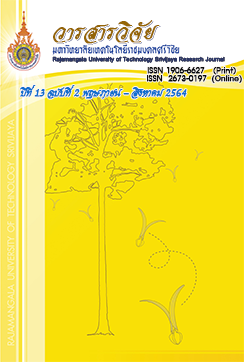Phytochemical analysis screening, antioxidant activity and preparation of lotion containing propolis extract from stingless bee
Keywords:
Propolis, antioxidant activity, phenolic compound, emulsion , lotion, Propolis, antioxidant activity, phenolic compound, emulsion, lotionAbstract
The purpose of this research was to analyze the phytochemical screening, antioxidant activity and preparation of lotion containing propolis extract from Stingless bees (Geniotrigona thoracica). The propolis was extracted by reflux method with ethanolic extraction for 1 hour. The ethanol extract (EE) of propolis was extracted with hexane and ethyl acetate, respectively, to obtain hexane extract (HE), ethyl acetate extract (EAE) and residue extract (RE). In the phytochemical screening analysis, chemical composition of all extracts included flavonoid, coumarin, saponin, terpenoid, steroid and cardiac glycoside. The result of antioxidant activity showed that EAE had the highest antioxidant activity with the IC50 value at 262.43 µg/mL and total phenolic content at 60.13 mg GAE/g extract. Therefore, the EAE was selected to prepare the lotion. Five formulations (F1-F5) of lotion were prepared with various concentrations of propolis extract. All of lotion formula represented the oil in water (O/W) type of emulsion and the range of pH with 6.12-6.50. The F3 lotion yielded better result than other formula which revealed homogeneity emulsion and stability temperature changes at temperature of 30±2 and 4±2 °C for 7, 15 and 30 days. However, the efficiency of antioxidant activity decreased after being stored for a long time. Based on this research, the data might be further used for the development of lotion formulations containing propolis extract in cosmetic industry.
References
Athikomkulchai, S. 2008. Propolis: A Gift from Nature. Thai Pharmaceutical and Health Science Journal 3(2): 286-295. (in Thai)
Ayoola, G.A., Coker, H.A.B., Adesegun, S.A., Bello, A.A., Obaweya, K., Ezennia, E.C., and Atangbayila, T.O. 2008. Phytochemical screening and antioxidant activities of some selected medicinal plants used for malaria therapy in southwestern Nigeria. Tropical Journal of Pharmaceutical Research 7(3): 1019-1024.
Boonsong, P. and Natedungta, W. 2014. Radical scavenging activity and phytochemical compositions of some tropical fruit plant leaves. The Journal of King Mongkut's University of Technology North Bangkok 24(3): 624-633. (in Thai)
Buachoon, N. and Sunthornsart, P. 2015. Development of lotion from Albizia myriophylla Benth cured extracts as antioxidant. VRU Research and Development Journal Science and Technology 10(2): 97-106. (in Thai)
Lobo, V., Patil, A., Phatak, A. and Chandra, N. 2010. Free radicals, antioxidants and functional foods: Impact on human health. Pharmacognosy Reviews 4(8): 118-126.
Montes, I., Lai, C. and Sanabria, D. 2003. Like dissolves like: A classroom demonstration and a guided-inquiry experiment for organic chemistry. Journal of Chemical Education 80(4): 447-449.
Moreno, M., Isla, M., Sampietro, A. and Vattuone., M. 2000. Comparison of the free redical-scavenging acivity of propolis from several regions of Argentina. Journal of Ethnopharmacology 71(1-2): 109-114.
Mouhoubi-Tafinine, Z., Ouchemouckh, S. and Tamendjari, A. 2016. Antioxydantactivity of some algerian honey and propolis. Industrial Crops and Products 88(2016): 85-90.
Muthukumarasamy, R., Ilyana, A., Fithriyaani, N., Najihah, N. A., Asyiqin, N. and Sekar, M. 2016. Formulation and evaluation of natural antioxidant cream comprising methanolic peel extract of Dimocarpus longan. International Journal of Pharmaceutical and Clinical Research 8(9): 1305-1309.
Pellati, F., Prencipe, F.P., Bertelli, D. and Benvenuti, S. 2013. An efficient chemical analysis of phenolic acids and flavonoids in raw propolis by microwave-assisted extraction combined with high-performance liquid chromatography using the fused-core technology. Journal of Pharmaceutical and Biomedical Analysis 81-82: 126-132.
Piluzza, G. and Bullitta, S. 2011. Correlations between phenolic content and antioxidant properties in twenty-four plant species of traditional ethnoveterinary use in the Mediterranean area. Pharmaceutical Biology 49(3): 240-247.
Thai Industrial Standards Institute (TISI). 2018. Herbal Body Cream/Lotion Product. THAI SMEs STANDARD 15-2018. Available Source: https://www.tisi.go.th/assets/website/pdf/tiss/15-2561.pdf, February 26, 2019. (in Thai)
Downloads
Published
How to Cite
Issue
Section
License
The content and information in the article published in Journal of Rajamangala University of Technology Srivijaya It is the opinion and responsibility of the author of the article. The editorial journals do not need to agree. Or share any responsibility.







